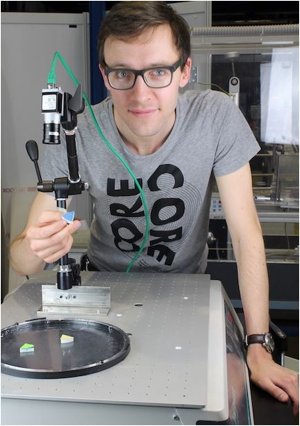Observing magnetic objects in fluids
Tijmen Hageman is a joint degree PhD-Student in the research group Robotics and Mechatronics of the University of Twente. His supervisors are Leon Abelmann and Gijs Krijnen from the Faculty of Electrical Engineering, Mathematics and Computer Science. The co-operation for this joint degree is with the Saarland University in Germany.
 Observation of the motion of particles in fluids give valuable information about the particles, the environment and the interaction between them. Two distinct particle-fluid systems were studied in this framework.
Observation of the motion of particles in fluids give valuable information about the particles, the environment and the interaction between them. Two distinct particle-fluid systems were studied in this framework.
The first system aims to provide more insight on the interaction of microscopic magnetic particles in fluids. Under certain conditions these particles can spontaneously form structures, a process called self-assembly. Such processes are difficult to observe in normal conditions due to the small size and time constants involved. On the other hand, computer simulations are time-consuming which scale unfavorably with the amount of particles involved. As an alternative we built a macroscopic reactor acting as an analog simulator. This machine suspends centimeter-sized magnetic particles in an upward water flow, which is a source of disturbing energy via turbulence and counteracts gravity. The trajectories of particles were recorded and analyzed by multiple cameras. We found that the motion and particle interaction show remarkable similarities with what the theory of microscopic particles predict. We furthermore found that the disturbing energy can be carefully regulated via the inflow of the water. We additionally found out that the geometry and aspect ratio of the particles have an enormous influence on the resulting assembled clusters.
The second system involves magnetotactic bacteria (MTB). These self-propelled organisms have an internal chain of magnetic crystals, aligning themselves with external magnetic fields. In nature they utilize this to align with the earth magnetic field. This converts a three-dimensional search towards their ideal habitat to a much more efficient one-dimensional search. By generating magnetic fields significantly stronger than the earth magnetic field we can utilize the bacteria as micro-robots, possibly for applications as targeted drug delivery within the human body. We characterized the response of MTB to magnetic fields by analyzing their trajectories in a microscope. Additionally we observed several parameters corresponding to growth and magnetic growth by monitoring the transparency of the sample over time.
The systems studied in this thesis have in common that the models underpinning their behavior can be completed from analyzing the motion of the particles. We have found that in both systems the interaction of magnetic torque and drag torque is key, as is the ratio of magnetic potential energy to thermal energy. So although these topics are very distinct at first sight, they share important concepts.





